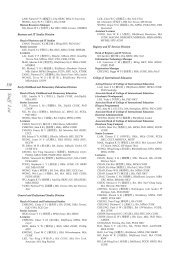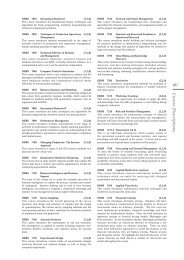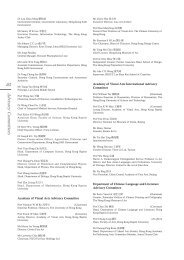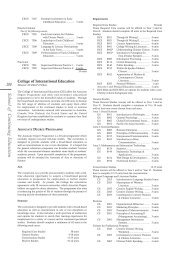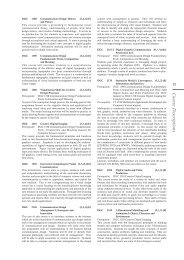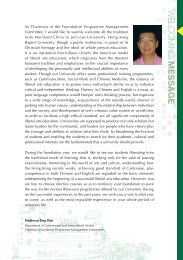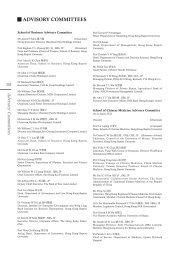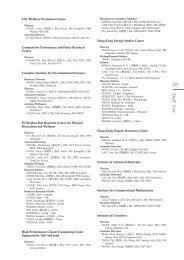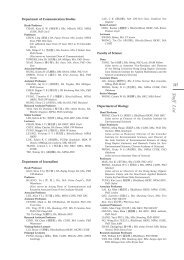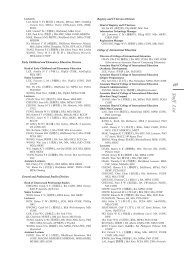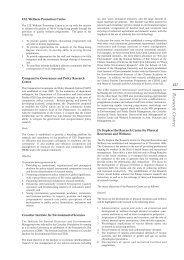374<strong>Course</strong> <strong>Descriptions</strong>GDSS 1817 Religion in the Development of (3,2,1)City Space and City LifeIn this course, students will learn how religions act as thepowerhouse of city development and city life in selected parts ofworld. Students are led to recognize that, beside secular ideologiesand economic, political, population and cultural necessities,religions have always played a pivotal role in people’s imaginationand in the construction of city life and city space. Students wouldbe invited to utilize concepts and methodologies learnt fromthe course to conduct value critique and ethical reflections oncontemporary urban development.GDSS 1836 Creativity 101 (1,1,0)The course objective is to improve individual’s creativity andinnovative skill by strengthening one’s mindset in observation,curiosity seeking, association, visualization, out-of-box thinkingand the ability to capture the flash of brilliance.GDSS 1845 Videogames and Arts (3, 3, 0)The course aims to provide an introduction to the study of games,videogames as an art form in particular, as well as understandinggames as a business, a cultural phenomenon and technologicalinvention. The game design process will be introduced as a wayto enhance problem solving skills and creativity. Students will berequired to design a new game using the principles learnt in classand at the same time to address social issues that related to theireveryday life experience.In the course, students will learn about gaming theory (Iudology)and the ways it apples to videogames, and as well as the fields ofart, business and technology about videogames. Audio and visualelements in videogames are obvious creative content. Game ingeneral is also a popular medium and strategy in contemporaryart production, since 1960s. Interactive art and design in thedigital era often displays game like characteristics. The study ofvideogames in the art context will provide students an alternativeperspective to understand the gaming experience they are familiarwith, and to encourage inter-disciplinary thinking.The course covers the aesthetics of games in the areas ofgenres, graphics, storytelling, gaming theory, interactivity, andcontemporary social issues. Upon completion of the courses,students will be prepared to reflect upon their own daily gamingpractices from more critical and creative perspectives.GDSS 1855 Celebrity and Entertainment (3,2,1)BusinessMore than just as a spokesperson of a product/brand, celebritiesand figures of fame play an important role in the creative sectorto date. This course maps the increasingly central importance offame and celebrity from a mass communication and marketingperspective. In this course, students will investigate the culture ofcelebrity in relation to entertainment, media, advocacy, identityand business models. It aims to introduce the phenomenonof stardom including some case studies of individual film,television, advertising, popular music and political stars, and toinvestigate the media influence of celebrities in a Chinese culturalcontext. This is fundamentally a preliminary course designedto help students think more critically about the intersection ofentertainment and civic engagement in the new media era. Italso aims to strengthen student’s understanding of the culture ofcelebrity on the societal values and choices in a Chinese culture.GDSS 1857 Service Leadership in Action (3,3,0) (E)(Health Services)The aim of this course is to introduce the concepts of serviceleadership and their actualization in health services, withparticular emphasis on Chinese medicine. It is envisaged thatthrough the sharing of experiences from stakeholders of thedifferent sectors of health services in <strong>Hong</strong> <strong>Kong</strong>, it will providea foundation for the students to draw up a service leadershipbusiness plan and deliver services in health care with competence,responsibilities and care in the future.GDSS 1865 Service Leadership and (3,2,1)Emotional IntelligenceIn order to become successful service leaders, our studentscan be well-prepared before they take up caring positions inthe community. A successful leader must possess abilitiesto understand self and others, to inspire and build strongrelationships and to respond effectively to the situations that oneis engaged in. This course thus brings together two significantcomponents of service leadership, namely leadership andemotional intelligence (EI) through the joint expertise of theSocial Work Department and Counselling and DevelopmentSection, office of Student Affairs. We believe that to preparestudents to become mature, capable and competent serviceleaders, there are essential knowledge, attitudes and skills to beexamined and learned in the areas of leadership and emotionalintelligence, and to apply them to real life situations.GDSS 1867 Children as Consumers: Marketing (3,2,1)to the YouthChildren and youth are future of the society. Due to theprolonged period of education, the position of youth hadbecome increasingly ambiguous. The course aims at introducingthe different perspectives and often competing interest amongmarketers, parents, educators, and policy makers regardingcommunication to children and youth. The course will begin withthe changing concepts of childhood and the position of childrenand youth in a social context. It continues with the cognitive andaffective responses toward commercial communication, as wellas development of the understanding of brands among childrenand youth consumers. Parental and peer influence and the roleof marketers and legislators will be explored. Ethical issuesconsidered by media executives, marketers, parents, citizens, andthe government regarding children as consumers will be discussed.The course will conclude by examining concems related withundesirable consequences of advertising to children and youthconsumers, such as unhealthy eating, gender stereotyping, andmaterialism.GDSS 1875 Uncovering the Stories of Brands (3,2,1)The objective of this course aims to motivate students tothink critically on diverse cultural and social issues. Thiscourse introduces students to the interplay of brands andperceptions in our daily lives. Emphasis is placed on studyingthe interwoven relationships among brands communication,society and consumers. The course aims to expand students' historical, social, economic and cultural perspectives. Throughdifferent theories and case studies, students will have a deeperunderstanding of how brands play a significant role in our socialand identity transfonnation. Students are also able to research,analyze, integrate and criticize various brands stories and socialdevelopment, and further apply the knowledge to their study andprofessional development.GDSS 1876 Psychology of Positive Living (3,3,0)The course is intended to introduce students’ basic concepts andknowledge of psychology of positive living. It is concerned withthe scientific study of different aspect of human functioningincluding behaviors, thoughts, emotions, learning and personalityas well as factors that enable individuals to flourish andachieve positive living, with an aim to promoting students’ selfunderstanding,knowledge and potentials in positive emotions,resilience, creativity and character strengths. The course iscomposed of two parts: (1) introduction of basic conceptsand knowledge of psychological study on human functioning;and (2) introduction of the key concepts and knowledge ofpositive psychology, with the joint expertise of the Social WorkDepartment and Counseling and Development Section, Office ofStudent Affairs.
GEOG 1005 Geography and the Contemporary (3,3,0) (E)WorldThe course deals with the complex physical and cultural realitiesof the world. It adopts a topical approach, encompassing majorissues in the contemporary world and studies these issues froma geographical perspective. It is designed in a manner that helpsstudents to understand the varied and complex environmentalinteractions of the Earth. The course also assists students inrecognizing the diverse ways in which geography can open newhorizons and contribute to the building of an environmentally andculturally sustainable world.GEOG 1130 Introduction to Quantitative (3,2,1) (E)Methods in GeographyThis course provides an introduction to statistical analysis ofgeographic data. Through real-world examples from various topicareas of geography, students learn sampling methods, descriptiveand inferential statistical techniques for analysing geographicdata. Topics include hypothesis testing, spatial statistics, statisticalrelationships between variables, and how to generate, summarizeand present geographic data, etc. The course will facilitatestudents a knowledge basis for understanding more advancedmethods of geographic analysis.GEOG 1150 Cartography (3,2,2) (E)Cartography is the art, science and technology of making maps.The process of map-making often involves five steps, that is,selection of a number of features in the real world, classificationof selected features into groups, simplification of jagged lines likecoastlines, exaggeration of features that are too small to show atthe scale of the map, and symbolization to present the differentclasses of features chosen. Understanding of this process andpursuit of the skills will greatly enhance the presentation ofgeographic information in graphic format. Moreover, this formatcan be an effective tool for data analysis such as examining therelationship between two distributions using simple transparentoverlays. Students of geography can apply such a mapping abilityto their natural or social science courses or in their professionalfields. The course also aims to introduce basic concepts andapplication skills of using geographical information system (GIS)to input, manage, retrieve and display geographical information.GEOG 1160 Cultures, Peoples and Landscapes (3,2,1) (E)This course examines the nature and development of culturalgeography and landscape studies as major fields of studies inhuman geography. It explores the interactive relationship betweenculture, social organization, human action, landscape featuresand the variation of place characteristics over space. It focusesespecially on (1) what by “culture” is meant, (2) how cultureevolves, develops, diffuses and changes, and (3) how we shallexplain and understand the interactive relationship betweenculture, society and place characteristics, especially within thedynamic and rapidly changing contexts of urban societies.GEOG 1190 Earth Systems: Shaping Landscapes (3,2,1) (E)This course introduces geomorphology and demonstrates themain facets contributing to the scientific study of landforms.Emphases are placed on plate tectonic theory, that is used asa framework to explain the Earth’s major relief features, theirdevelopment and structure, and the associated landforms; and theprocesses of weathering, erosion and deposition with regard tolandform development especially in <strong>Hong</strong> <strong>Kong</strong>.GEOG 1200 Earth Systems: Atmosphere and (3,2,1) (E)BiosphereThe first part introduces climatology. Emphases are placed onatmospheric motion and climate change. The second part is acomprehensive analysis of the development and characteristics ofsoil and vegetation on the Earth’s surface. Emphasis is placed ontheir distribution, soil-plant interactions and their significance inhuman’s use of land.GEOG 1210 Globalization of Economic (3,2,1) (E)ActivitiesThis course introduces students to the world phenomenon ofglobalization of economic activities. It is imperative for studentsin Geography to be aware of the basic features and the processesof economic globalization: What is it? Who are the main actorsbehind it? How did it happen? What are the implications for thespatial organization of economic production and the patterns ofurban agglomerations at various geographic scales: the world, thenation, and the region? This course aims at providing a systematicintroduction to these basic features.GEOG 1610 People and the Physical (3,3,0) (E)EnvironmentStudents are introduced to the processes and problems associatedwith the physical environment in which people live, and examineshow humans, in turn, influence and control their surroundings.Contemporary problems such as global warming, ozone depletionand desertification are examined. Special emphasis is given toexamples from <strong>Hong</strong> <strong>Kong</strong> and China. This course is not open toGeography majors.GEOG 1620 <strong>Hong</strong> <strong>Kong</strong> and the Pearl River (3,2,1) (E)Delta: A SurveyThis course provides a comprehensive and lively guide to thehistory, culture, geography and economic development of SouthChina. This objective is to be achieved by a series of wellorganizedlectures and tutorials. Field trips, both in <strong>Hong</strong> <strong>Kong</strong>and to the Pearl River Delta, which will provide an invaluable onsiteexperience to elaborate the types and magnitude of changein South China discussed in lectures, may be organized. It ishoped that this course will constitute an essential gateway to thosewishing to acquire a deeper understanding of this dynamic cornerof Asia.GEOG 1630 Geography, Information (3,3,0)Technology and Modern LifeThis is an introduction course to the application of geo-spatialinformation technology. It is designed as a complementarycourse for non-geography major students for the awarenessand understanding of applications of modern technology togeographical issues. The course will emphasize the use of GIS,GPS and remote sensing to solve some common problems andissues in today’s industry and the modern life of the society.The currently available resources of geographical data and dataprocessing tools for various typical applications will also beintroduced.GEOG 1640 Energy, Environment and (3,3,0)SustainabilityClimate change and the depletion of energy resources are issuesof major international concern in the contemporary world. Thefocus of this course is on the multiple and intricate relationshipsbetween energy, environment and sustainability issues. Itallows students to fully understand the subject matter from boththe natural science and social science perspectives. Throughappropriate real-life examples, the course aims to guide students,in an exploration of viable alternative energy sources and toenable them to embark on a way of life that promotes a clean andsustainable use of energy resources. In addition to classroomlearning, the teaching will be supplemented by field visits,demonstrations, group projects and debates.GEOG 2005 Cultures, Peoples and Landscapes (3,2,1) (E)The course examines how geographic location and people’scultural identities shape landscapes from both a physical settingand a symbolic construction point of view. Places or locationscan be linked physically through processes of migration, tourism,trade, and investment, and represented (or “imagined”) throughmedia such as newspapers, film, music, art and literature. Theseprocesses are influenced by, and impact on, the natural andcultural landscapes.375<strong>Course</strong> <strong>Descriptions</strong>
- Page 3 and 4:
economic growth, trade, pollution,
- Page 5 and 6:
specific empirical economic problem
- Page 7 and 8:
of private enterprises in the indus
- Page 9 and 10:
period. The first part of the cours
- Page 11 and 12:
The reactions and effectiveness of
- Page 14:
314Course DescriptionsEDUC 3080 Tea
- Page 17 and 18:
development of children and adolesc
- Page 19 and 20:
and communication skills in differe
- Page 21 and 22:
y ubiquitous technology. Learners w
- Page 23 and 24: ENG 2650 Topics in English Grammar
- Page 25 and 26: clause structures of the English la
- Page 27 and 28: adopted for reading and interpretin
- Page 29 and 30: drama; and (2) introduce Western dr
- Page 31 and 32: ENGL 4005 Advanced Topic in Compara
- Page 33 and 34: attendant to the break-up of mediev
- Page 35 and 36: EURO 3205 Comparative Politics of (
- Page 37 and 38: states, enlargement provides signif
- Page 39 and 40: to create and develop ideas via rel
- Page 41 and 42: strategies of awarded campaigns to
- Page 43 and 44: characteristics of films, film-make
- Page 46: 346Course DescriptionsFINE 1005 Fin
- Page 49 and 50: GCHC 1005 China and the Global Econ
- Page 51 and 52: the period with a special focus on
- Page 53 and 54: est decision-making procedures. Mor
- Page 55 and 56: GCPE 1065 Table Tennis (1,2,0) (C)T
- Page 57 and 58: and/or philosophical traditions the
- Page 59 and 60: on the use of English in various se
- Page 61 and 62: GDAR 1835 Music, Mind, and Human (3
- Page 63 and 64: lead to successful development of n
- Page 65 and 66: management and proactive stakeholde
- Page 67 and 68: GDCV 1065 Buildings of Hong Kong: (
- Page 69 and 70: of various religions that broaden t
- Page 71 and 72: their implications for contemporary
- Page 73: gone through since 1945 included th
- Page 77 and 78: students to the concepts and techni
- Page 79 and 80: GEOG 3730 Energy Policy and Analysi
- Page 81 and 82: processes interact with China’s s
- Page 83 and 84: GERM 1006 German II (3,3,0) (G)Prer



